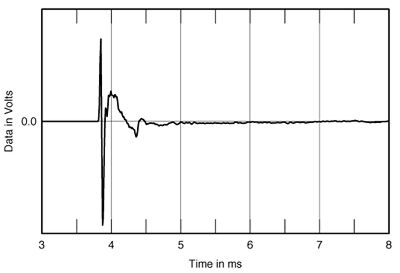| Columns Retired Columns & Blogs |
PSB New Stratus Mini Measurements part 2
The Stratus Mini's spatially averaged response in my listening room (fig.7) correlated quite well with my listening impressions. A small excess of mid-treble energy, presumably due to the flare in the speaker's dispersion at the bottom of the tweeter's passband, compensates somewhat for the slight lack of on-axis energy in the same region. The bass peaks up a little due to the residual 63Hz room mode that's never quite absent from this measurement, with usable low frequencies present down to the 31.5Hz band.

Fig.7 PSB New Stratus Mini, spatially averaged 1/3-octave response in JA's room.
Figs.8 and 9 show the New Mini's impulse response taken without and with the grille, respectively. A sharp discontinuity in the trace is evident in fig.5, about 0.5ms after the sound's first arrival at the microphone. I assume that this is due to reflection from the cabinet "lip" that is suppressed when the grille is in place. The step response, taken with the grille (fig.10), reveals that even on the listening axis, the tweeter's output is slightly ahead of the woofer's. Both drive-units are connected with positive acoustic polarity, however. The associated cumulative spectral-decay plot (fig.11) reveals a very clean initial decay correlating with the PSB's grain-free presentation.

Fig.8 PSB New Stratus Mini without grille, impulse response on listening axis at 50" (5ms time window, 30kHz bandwidth).

Fig.9 PSB New Stratus Mini with grille, impulse response on listening axis at 50" (5ms time window, 30kHz bandwidth).

Fig.10 PSB New Stratus Mini with grille, step response on listening axis at 50" (5ms time window, 30kHz bandwidth).

Fig.11 PSB New Stratus Mini, cumulative spectral-decay plot at 50" (0.15ms risetime).
The original Stratus Mini suffered from some lower-midrange congestion due to a strong cabinet resonance just under 370Hz. The resonance was of high Q, meaning that an instrument or voice needs to linger on that exact frequency for more than a fraction of a second for it to be excited. However, because 370Hz is the frequency of the F-sharp on the first space of the treble staff, it was easily possible for the resonance to color the sound. Fig.12, generated from the output of a simple piezoelectric PVDF accelerometer, indicates that the New Mini does have quite a strong cabinet resonance, detectable on all surfaces, at 465Hz. Although its frequency almost coincides with that of the B-flat in the middle of the treble staff, this mode is significantly higher in frequency than in the earlier speaker, which means that its effect on the music will be much reduced.—John Atkinson

Fig.12 PSB New Stratus Mini, cumulative spectral-decay plot of accelerometer output fastened to side of enclosure (MLS driving voltage to speaker, 7.55V; measurement bandwidth, 2kHz).
- Log in or register to post comments




































